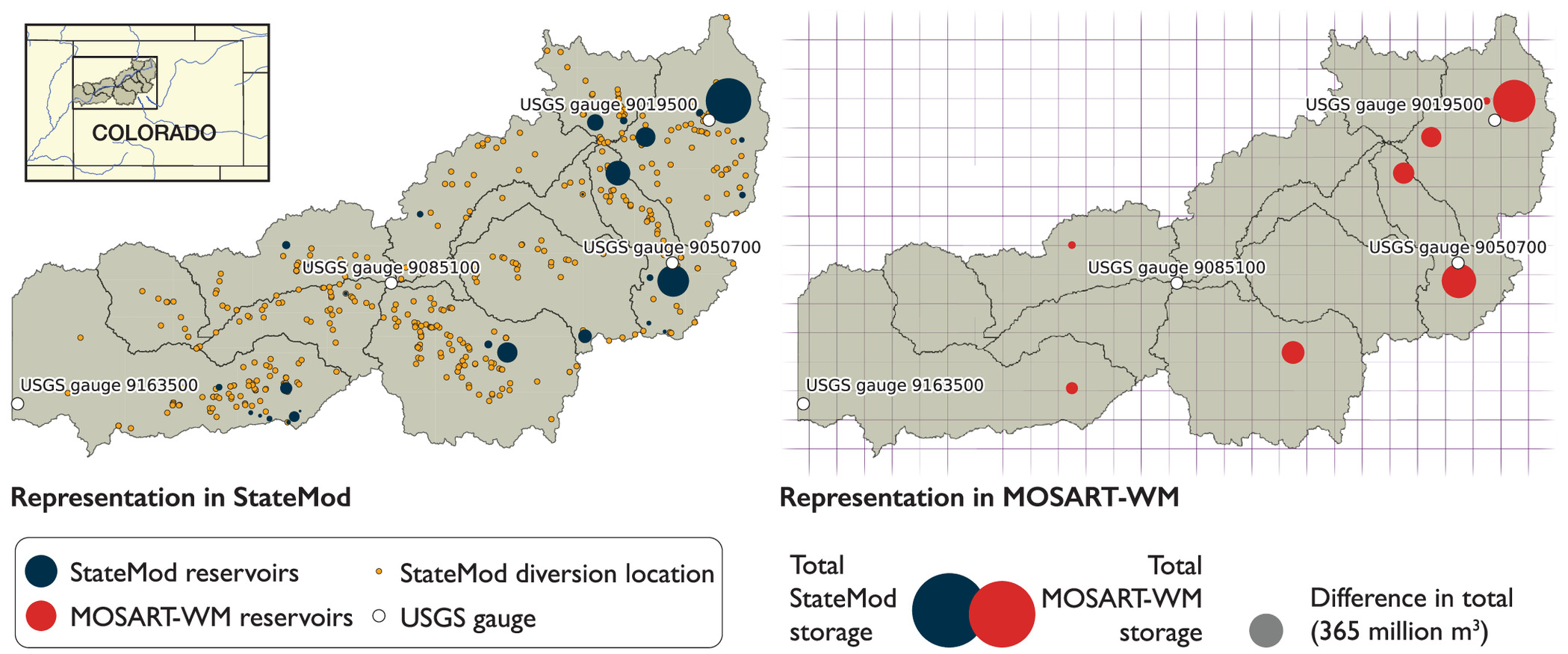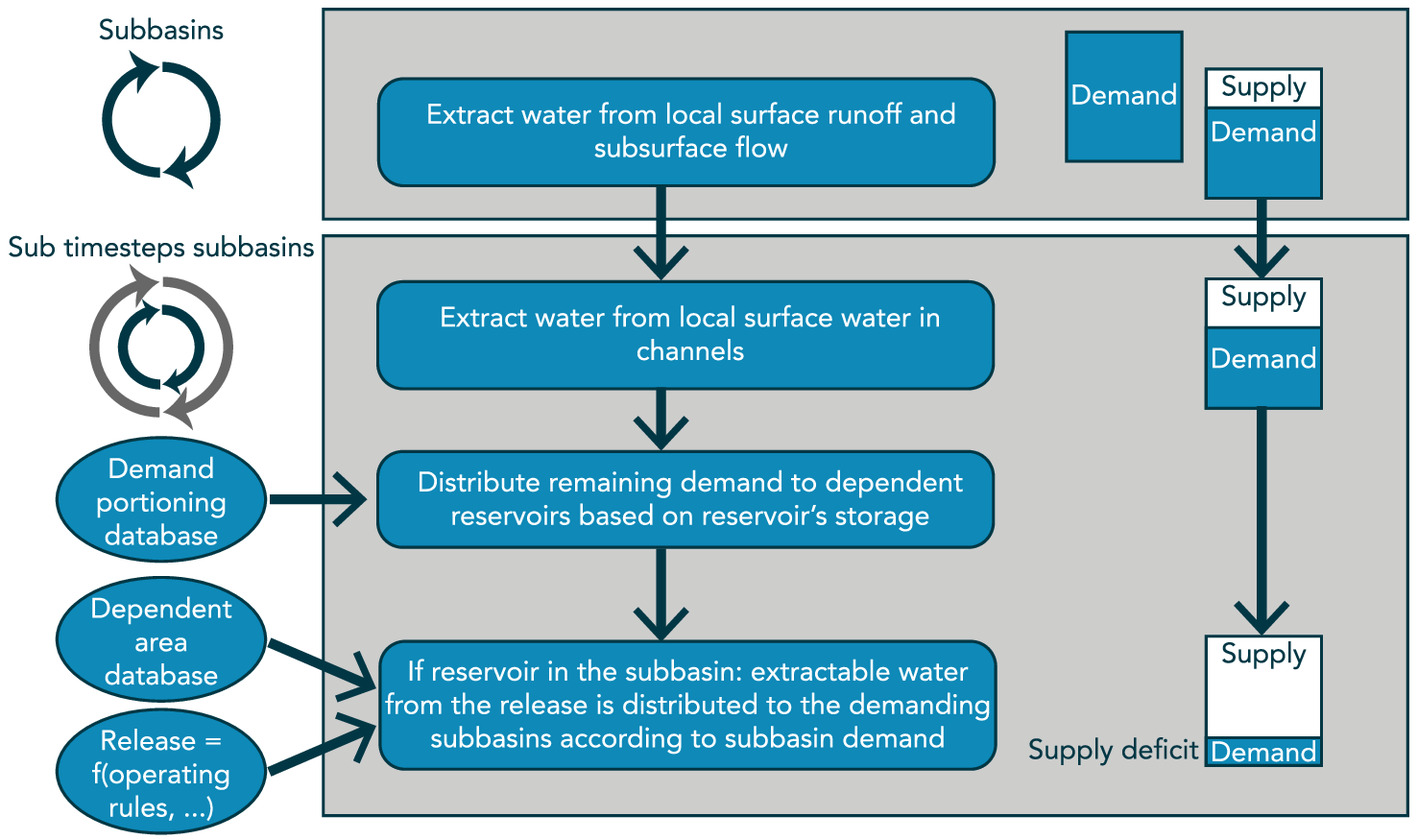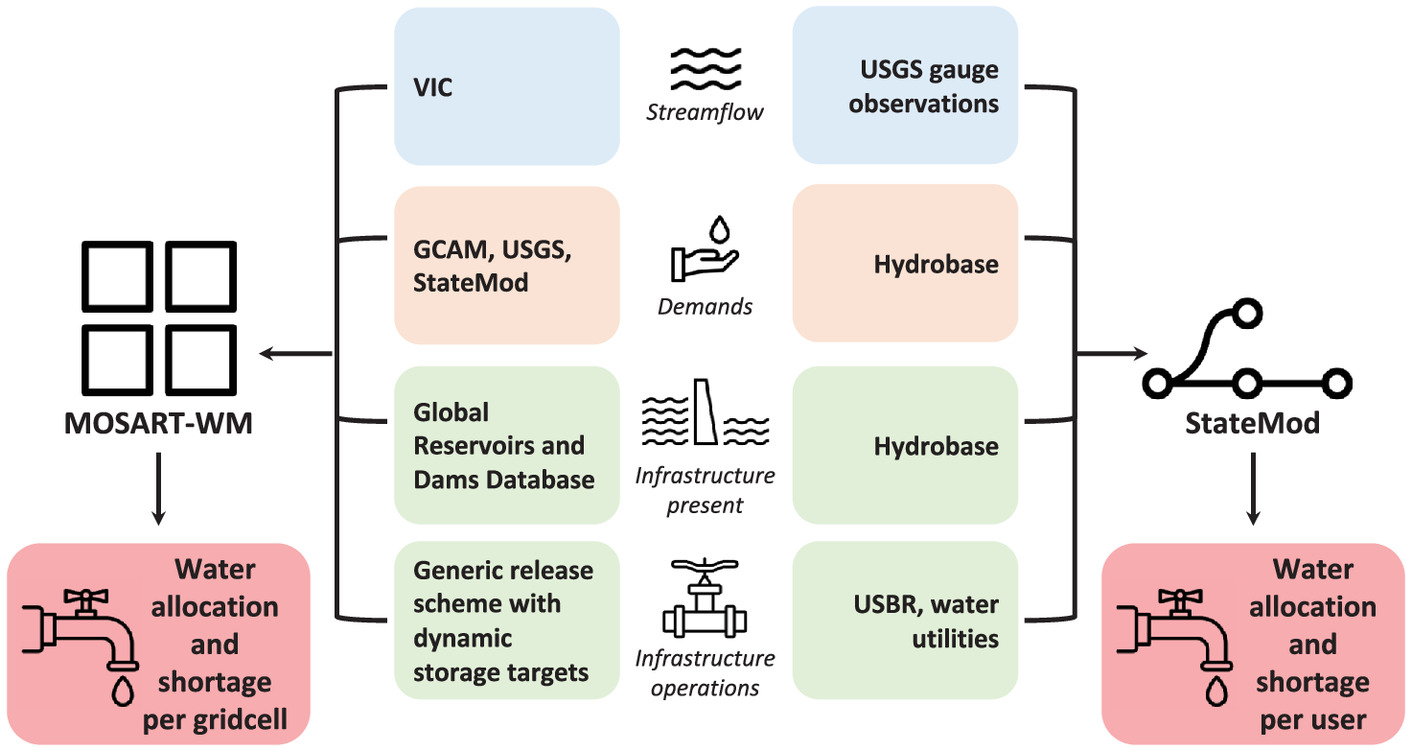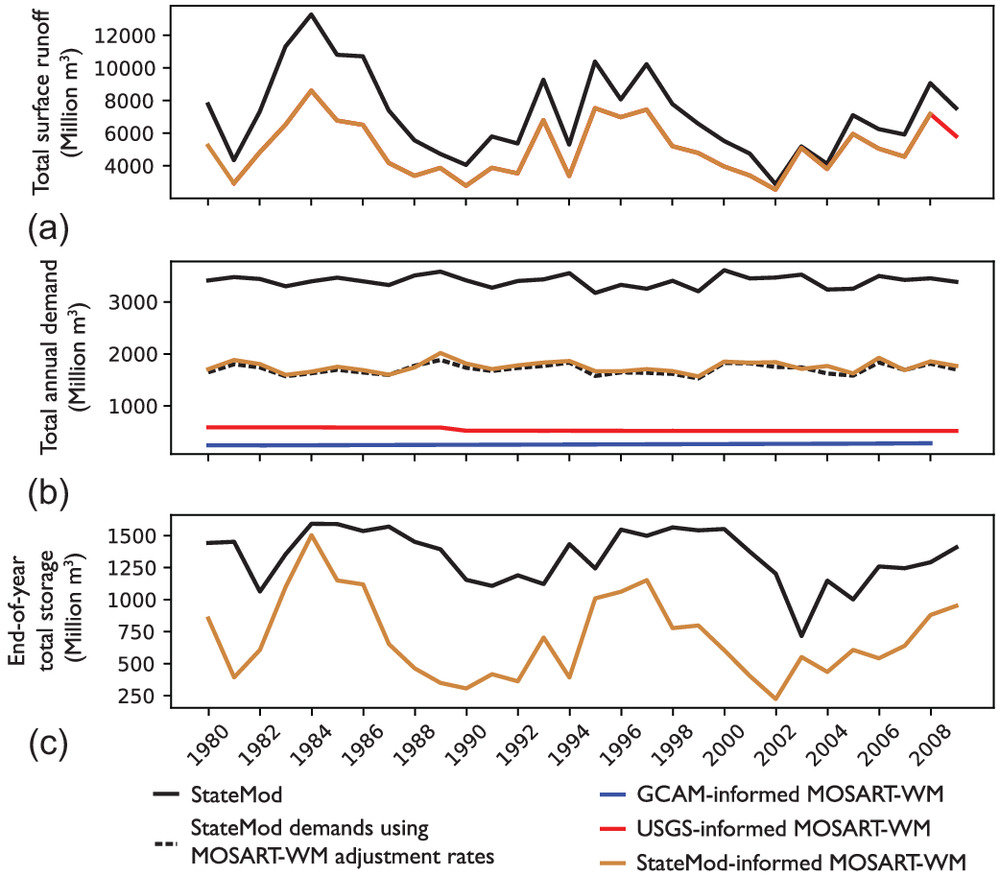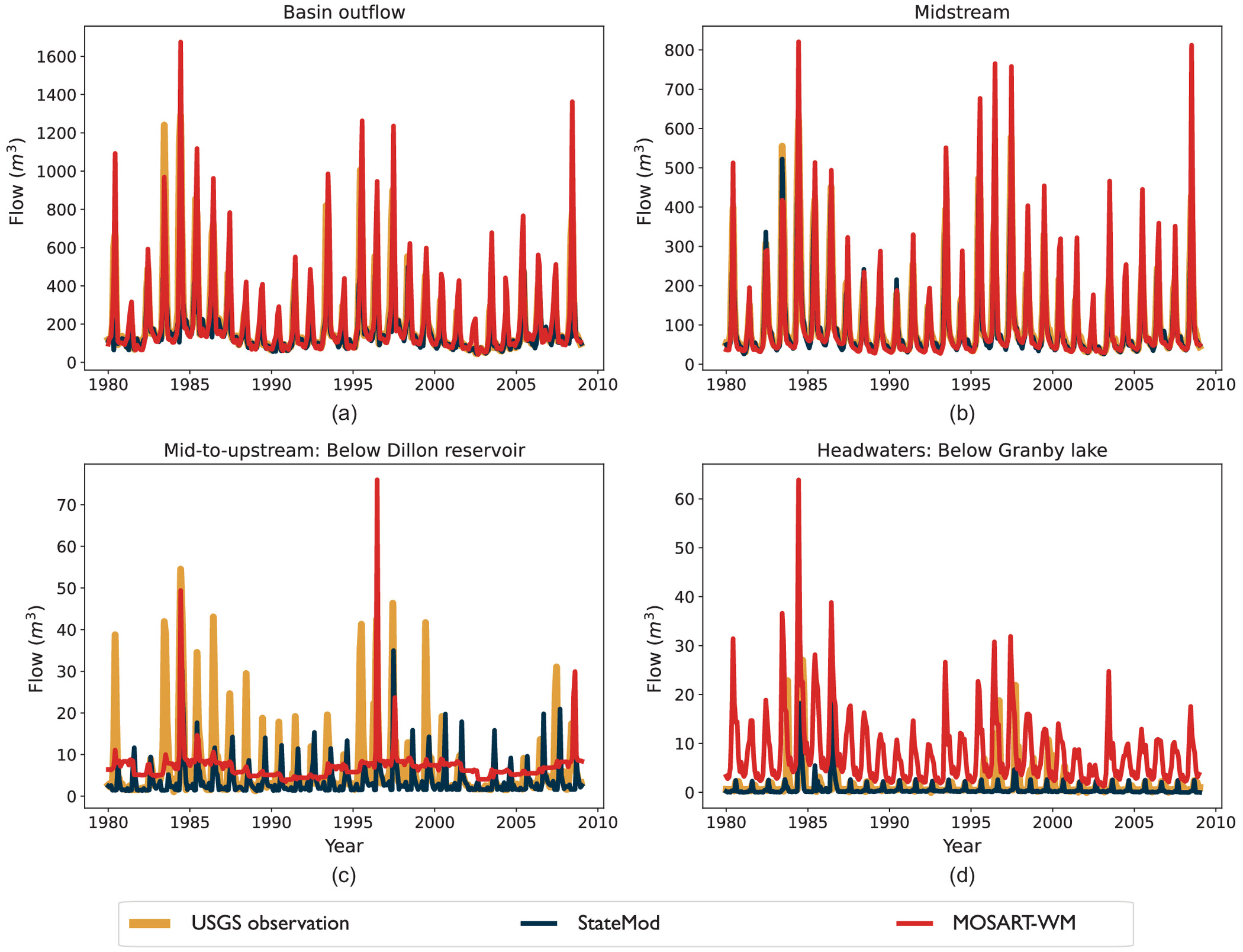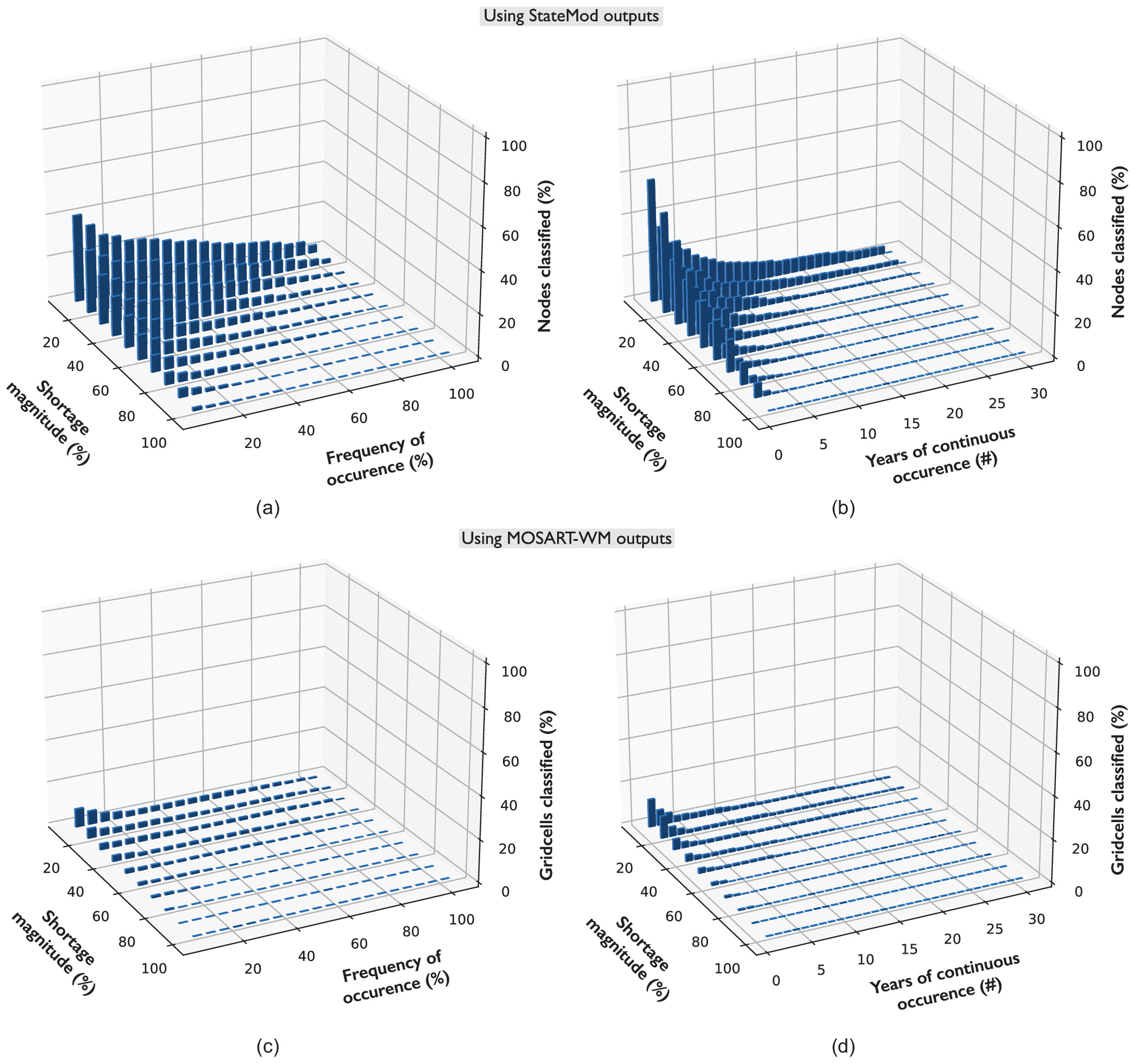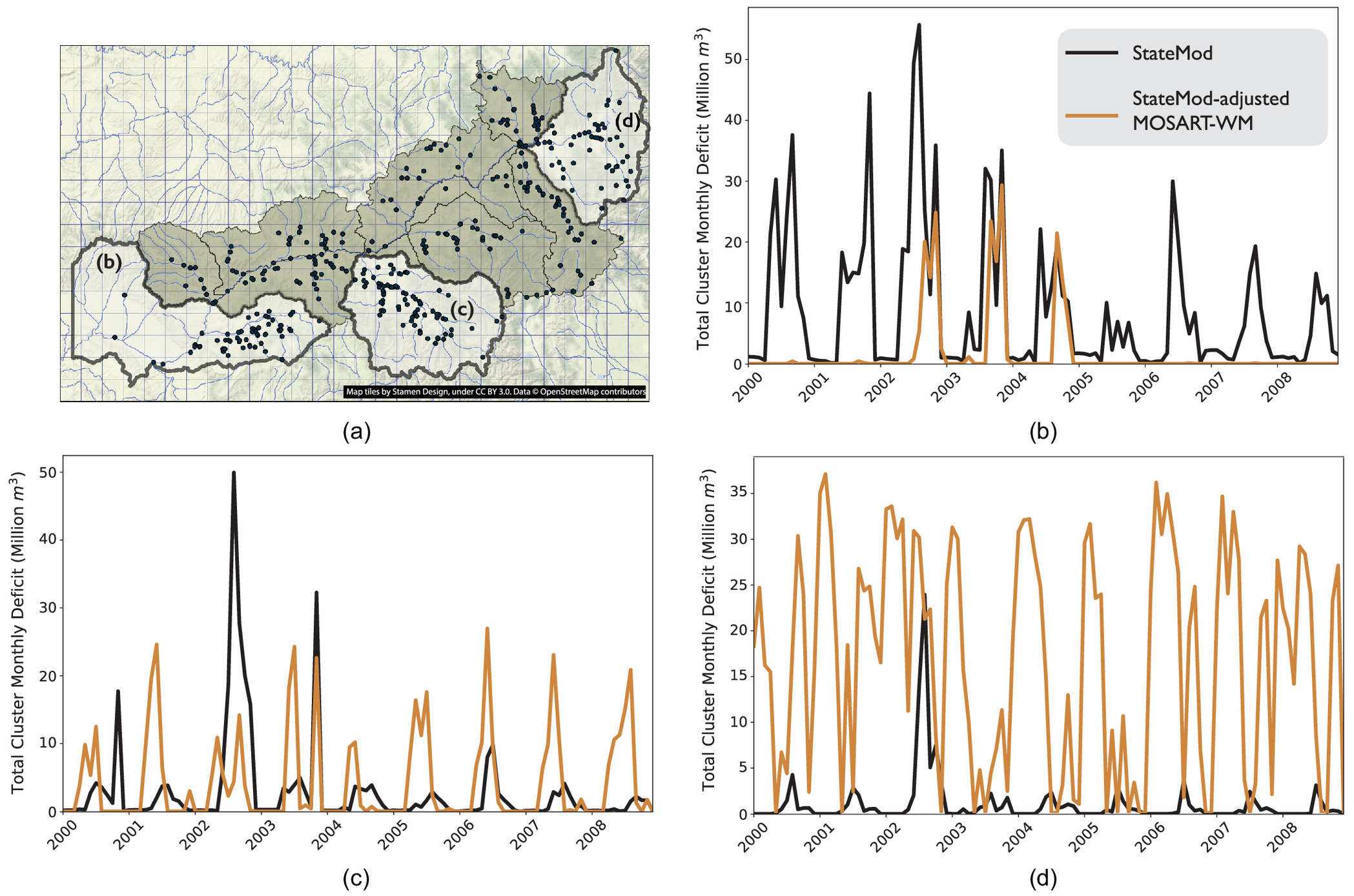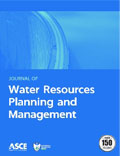Introduction
Societies around the world have long struggled with how to best allocate and manage water resources among multiple competing uses. Simulation modeling is a principal tool for analyzing the behavior of water resources systems, evaluating future conditions, and assessing alternative management policies. In research efforts modeling water management under future conditions, a divide has emerged between global modelers focused on hydroclimatological processes and water-systems modelers focusing on the environmental, infrastructural, and institutional features that shape water scarcity at the local basin level. Both communities are interested in addressing similar societal and scientific questions, namely how changes in the availability and allocation of water affect its human uses, and how human uses impact the spatial and temporal distribution of water resources as well as other natural processes. The two communities approach these questions from different vantage points. Water systems models emphasize the representation of elements pertaining to water management and use. They require downscaled inputs of the climatic conditions that shape water availability in their watersheds (e.g.,
de Boer et al. 2021;
Fereidoon and Koch 2018). Large-scale water management models are typically one component of large-scale hydrologic models that emphasize the representation of regional and global hydroclimatic processes and thus are constrained to using simplified representations of the human systems elements (
Nazemi and Wheater 2015a,
b).
Watersheds and river basins are defining spatial domains for such analyses because environmental changes or human actions taking place in one part of a basin often have implications for another (consider, for example, the effects of upstream agricultural return flows or of a downstream reservoir construction). Assessing water scarcity vulnerabilities at these scales requires not only careful accounting of the geophysical processes taking place, but also of the human elements that shape the movement of water: physical infrastructure and human uses, as well as the institutional and governance elements (
Loucks and van Beek 2017). The inclusion of infrastructure and institutional elements is often intrinsically linked with ensuring the insights from water scarcity vulnerability analyses are decision relevant (
Hadjimichael et al. 2020). Regional water management agencies and river basin commissions therefore face significant requirements beyond standard model evaluations; the diverse representations of water demands and the rules of supply allocation require careful accounting of stakeholders’ interests in a river basin (
Barrow 1998;
Palmer et al. 2013).
Table
1 summarizes how some of the most prominent regional water resources systems models abstract these elements. Focusing on water allocation processes, typically, river basin models abstract the water system into a node-link network, in which nodes represent either sources or reservoirs of water in a system or a demand location, and links represent the conveyance via which water is transported from one to the other. Key sectoral demands (energy, agriculture, and industry) are then associated with specific model nodes and can vary substantially across different administrative divisions (counties, cities, and towns) due to both climatic and socioeconomic distinctions. Basin-scale water management models represent multisectoral demands at various levels of complexity, depending on the problems to which they are applied, but typically aim to represent several stakeholders and actors [literature reviews have been given by Brown et al. (
2015), Tomlinson et al. (
2020), Trindade et al. (
2020), and Zomorodian et al. (
2018)]. Such models are largely data-driven and developed specifically for the basin they represent. Developers have to specify demand levels or curves for each use type and water allocation mechanisms, such as rules, compacts and laws (
CWCB and CDWR 2016;
Purkey et al. 2008;
Vicuna et al. 2007;
Wheeler et al. 2016;
Zeff et al. 2021).
Models at this scale also explicitly represent the availability and capacity of storage and conveyance infrastructure present in the basin. In terms of reservoirs, specific operating rules and constraints need to be described using control rule curves, specific releases and restrictions, or target levels. This level of specificity enables detailed, component-specific analysis of impacts in the basin as a result of management decisions or environmental changes. Vulnerability to water scarcity can be evaluated with regards to shortage to utility- or user-specific water deliveries (
Hadjimichael et al. 2020;
Palmer and Characklis 2009;
Yoon et al. 2021), or looking at sectoral impacts, such as on agricultural productivity or power generation (
Quinn et al. 2018;
Yang et al. 2015;
Zeff et al. 2021).
Decision makers responsible for the studied basin can also use these models to compare how impacts differ across their stakeholders as well as evaluate the tradeoffs between them, especially in a planning context. Due to the practical challenges of developing such data-intensive analysis tools and computational demands, these models are not typically used to study water scarcity vulnerabilities at a resolution needed to promote collaborative planning among stakeholders at larger regional or national scales (
Dobson et al. 2020). This limited representation at the watershed scale may lead to either overconfident or underconfident vulnerability assessments in larger contexts because even though the watershed is a logical boundary from the point of view of local decision making, water resources problems are in fact shaped by events taking place outside the river basin, such as atmospheric, land, and hydrologic processes, as well as human systems. Information about these processes and how they shape the availability of water is typically external to basin-scale models, which rely on downscaled hydroclimatic and other time series to be used as input.
Large-scale hydrologic models (LHMs) have been developed to place more emphasis on the water cycle rather than energy and carbon processes, and to better account for the effects of anthropogenic changes on regional and global water cycles (
Haddeland et al. 2006a;
Hanasaki et al. 2006;
Wada et al. 2017). LHMs solve the local water balance across large scales and use accumulated gridded runoff and base flow to estimate discharge over river networks. They employ conceptual models for their calculations, avoiding the data-intensive requirements of basin-scale models and maintaining parsimony in the modeled representations across large hydrologic regions. With large-scale data sets becoming more available, LHMs have seen increasing the sophistication of their representation of hydrologic processes (Table
1). Paired with spatially distributed water management models, LHMs have also been used to study multisectoral effects, such as water scarcity impacts on the energy and agricultural sectors (
Condon and Maxwell 2014;
van Vliet et al. 2016;
Voisin et al. 2018). Although sectoral demand allocation can be represented regionally (
Voisin et al. 2013b), the continental and global simulations mostly focus on irrigation water demand and changes in water availability (
Haddeland et al. 2014;
Wada et al. 2016).
Spatially distributed sectoral water demands are typically an input to LHMs. The complexity of deriving spatially distributed transient and sectoral water demands as drivers of multiscale hydrology motivates the need to better represent the interactions between sectoral water demand and water availability (
Haddeland et al. 2006b;
Hanasaki et al. 2006). Integrated assessment models (IAMs), such us the Global Change Assessment Model (GCAM), are market equilibrium models that simulate water demands for human activities by accounting for several global markets [e.g., agricultural production, electricity, and manufacturing (
Hejazi et al. 2014a,
b,
2013)]. Water demand data generated from GCAM are often used as input to LHMs that in turn simulate surface runoff and the allocation of water to different demands, including reservoir releases. Such analyses can be used to assess water scarcity in regional to global scales and its impacts to multiple sectors, as well as the effects of various policies on water availability (
Dolan et al. 2021;
Graham et al. 2020;
Hejazi et al. 2015;
Khan et al. 2020;
Kyle et al. 2021).
We therefore observe the growing confluence of two branches of research addressing water scarcity through a focus on water supply availability and allocation; each relies on different scale-dependent dynamics: basin-scale water systems models and LHMs. The two classes of models have been converging toward one another, with basin-scale models directing efforts toward improved incorporation of hydroclimatic processes (
Beh et al. 2017;
Burrow et al. 2021;
Quinn et al. 2018) and LHMs directing efforts to more accurately represent how humans manage and use water (
Turner et al. 2020;
Voisin et al. 2017;
Wada et al. 2017;
Yassin et al. 2019). The main objective of this study is to explore the consistency of water scarcity inferences drawn from a representative model from each of these two classes of models: State of Colorado’s Stream Simulation Model (StateMod) and model for scale adaptive river transport (MOSART)—water management (WM).
The aim here is not to compare model performance with regards to the accuracy of their basin-scale predictions—in fact, MOSART-WM has to make simplifying assumptions in its predictions at the subbasin scale as a means of enabling continental- to global-scale analyses. Rather, this study seeks to better understand how the modeling choices and differences in system representations employed by StateMod and MOSART-WM impact the water scarcity inferences they produce in a human-activity dominated basin, such as those within the Upper Colorado River. This model intercomparison sheds light on how to most appropriately interpret large-scale studies on water scarcity as well as how the two scales of analysis may be bridged to balance both large-scale dynamics and decision-scale relevance.
More specifically, we would like to address the following two questions. From the perspective of the basin-scale water systems modeling community, can LHMs inform how to appropriately capture processes and interactions happening outside the basin that nonetheless shape locally relevant conditions? From the perspective of the LHM community, can high-resolution basin-scale models inform how human processes are accounted for in regional scales?
Results
Due to the differences in scale and structure between the two models as well as their state variables, the comparison of inferences about water scarcity drawn from the two was performed across several scales (basinwide, upstream to downstream gauges, individual, and grouped shortages), several state variables (streamflow, storage, and water shortages), and several water shortage metrics (500 combinations of magnitude, frequency, and duration). Three instances of MOSART-WM were simulated, namely GCAM-informed, USGS-informed, and StateMod-informed, each referring to the respective data set informing the water demands used as input. We used all three instances for the basinwide comparison but only focused on the StateMod-informed MOSART-WM run for subsequent comparisons of monthly streamflow and shortages because it eliminated the demand discrepancy between the two models, as can be seen in Fig.
4(b) and discussed subsequently.
Inferences drawn from the two models are first compared at the basin scale, presented in Fig.
4. Total surface runoff [Fig.
4(a)] was the same across all three MOSART-WM runs because it is an input to the model, indicated by the brown line. Total surface runoff in StateMod is indicated in black and represents the sum of runoff and return flows. Surface runoff inputs to MOSART-WM were obtained through large-scale hydrologic simulations by Brekke et al. (
2014) using the macroscale VIC model. Total surface runoff in MOSART-WM does not include return flows in these runs because only the consumptive parts of demand are diverted from the surface flow. The MOSART-WM surface runoff input from VIC appears to underestimate total surface runoff in this basin [Fig.
4(a)], especially during wetter periods (e.g., 1982–1988). This difference is attributed directly to the VIC model used to produce this runoff input. The Brekke et al. (
2014) evaluation was conducted at a downstream location for a larger drainage area and has not been calibrated to this scale. Both models capture the occurrence of dry periods in the region (e.g., 1988–1992 and 2002–2006), as noted in the literature (
Pielke et al. 2005;
Rhee et al. 2018).
Different total annual demands inform the two models [Fig.
4(b)]. StateMod represents water demands as the ideal amount the user or structure would have diverted absent physical or legal availability constraints, as described in previous sections. Depending on the available flow and the users’ right seniority, only part of the water demands is allocated to users, resulting in shortages to users throughout the basin. Out of the total allocated volume of water across the basin, approximately 20% is consumed on average every year, with the rest being returned to the stream at variable rates depending on type of water use and its location.
Water demands in MOSART-WM represent only consumptive use demands, in other words, only the consumptive component of what is allocated (which is, by definition, lower than the ideal water demands used for accounting by the state and its models). To allow direct comparison between the StateMod water demands and the consumptive water demands used by MOSART-WM, we used withdrawal-to-consumption ratios for each type of use, as explained in previous sections. The resulting conversion is shown in Fig.
4(b) as a dashed line. Be that as it may, the original MOSART-WM (line in blue), which uses downscaled water demand forcings from GCAM, as well as the adapted version of MOSART-WM, which uses adjusted water demand data from USGS (line in red), both underrepresent these demands for consumptive use: the GCAM-informed demands and the USGS-informed demands are approximately 10% and 25% of the StateMod-informed demands, respectively [Fig.
4(b)].
Lastly, Fig.
4(c) compares the total end-of-year (December) stored volume of water across the basin, as represented by the two models. All instances of MOSART-WM (GCAM-, USGS-, and StateMod-informed) had the same storage values because most of the represented demand is downstream of the reservoirs and reservoir operations are essentially driven by monthly inflow climatology. Total stored volume was underrepresented by MOSART-WM, largely due to the underrepresentation of available storage in the basin (Fig.
1). StateMod represented the entire storage capacity in the basin, at 1,811 million
. In StateMod and with the Colorado State institutional structure, reservoir storage is specifically managed to meet the demand. Approximately 75% of the reservoir capacity was used at varying levels during the 1980–2009 period, dropping to around 40% at the end of 2003 (year after the driest). MOSART-WM represents a smaller storage capacity in this basin, 1,446 million
, because the reservoirs represented in the GRanD database have a minimum cutoff of storage capacity being greater than
(
Lehner et al. 2011). This capacity was also used at lower levels: stored water in the basin was represented at approximately 49% of the available storage, with the lowest level reaching 16% of total capacity in 2002. Fig.
S1 presents the same results, but with the fraction of reservoir storage in each model instead of their absolute volumes. It is worth noting that the two models start with different storage levels, which also vary much more substantially in the MOSART-WM simulation (coefficient of variation for StateMod reservoir levels is 15.8%, and for MOSART-WM it is 45.3%).
With regards to streamflow, the two models are compared against USGS observations at four gauges in the basin (Figs.
5 and
S2). At the basin outflow and the midstream location [Figs.
5(a and b)], both models tracked the observed flow time series fairly closely. At the gauge below Dillon reservoir, on the Blue River tributary, MOSART-WM appears to underestimate high flows and overestimate low flows [Fig.
5(c)]. Because this gauge is located below the Dillon reservoir, the low-flow discrepancy could be attributed to reservoir releases not represented in the model during those periods. The last gauge is located in the headwaters of the river, below Granby Lake [Fig.
5(d)], where both models diverge from observations—this is seen more notably when comparing flow duration curves [Fig.
S2(d)]. This is partly because both models were calibrated starting from the basin outflow and struggled to match observations closer to the headwaters. Another potentially contributing factor here is the fact that this USGS gauge lacked streamflow measurements from October until April for most of the comparison period. To allow a comparison here, we used average monthly observation values from months in the record that were available, as calculated during the StateMod calibration process (
CWCB and CDWR 2016). It is also worth noting here that the water demands used in the MOSART-WM simulations (i.e., GCAM-, USGS-, or StateMod-informed) did not affect the simulated streamflow presented.
To understand the effects of the discrepancies between the two models on the inferences one would draw about water scarcity in this basin, we looked at water shortages estimated by the two models. For StateMod, shortages were estimated at each model node, each of which represents a diversion location or a small group of them. In MOSART-WM, shortages were estimated at model grid cells (representing a spatial subsection of the basin). To limit the potential bias introduced by the choice of water scarcity metric as well as ensure their relevance across decision makers and stakeholders in such a multiactor basin, we used two types of metrics: (1) one focused on combinations of shortage magnitude (percentage of demand) and frequency (percentage of time), and (2) the second focusing on shortage magnitude (percentage of demand) and duration (number of continuous years), as detailed in the “Methods” section. Fig.
6 presents the resulting vulnerability classification of users in this basin, with Figs.
6(a and b) showing classified nodes using StateMod outputs and Figs.
6(c and d) showing classified grid cells using MOSART-WM outputs.
Fig.
6(a) shows the percentage of StateMod nodes that would be classified as vulnerable under the different combinations of magnitude and frequency levels. For example, if we choose as our metric that a user is vulnerable to water scarcity if they experience a water shortage of 10% of their demand 5% of the time (i.e., the column in the back left corner of the flat plane) then 41% of them would be classified as vulnerable. The remaining 59% of users experience shortage levels that are either smaller in magnitude or less frequent, or no shortages at all, under the conditions present during the 1980–2009 period. Because this is the strictest metric combination considered (acceptable levels of magnitude and frequency are the lowest), it follows that this is also the maximum percentage of users that would be classified as being vulnerable under any of the remaining magnitude and frequency combinations.
Alternatively, as an illustrative example for the metric considering combinations of shortage and duration [Fig.
6(b)], a user is vulnerable to water scarcity if they experience a water shortage of 10% of their demand for 5 consecutive years (i.e., the fifth from the left column in the back of the flat plane) yielding the classification of 22% of the users as being vulnerable. Under any combination of shortage-duration metrics, the largest number of users that would be classified as vulnerable to water scarcity is 58%. Lastly, in Figs.
6(a and b), there is always a small number of users that experience at least some level of shortage (columns in the back right corners of both panels).
The implication of these StateMod results is that even with the strictest metric combinations considered, approximately half of the basin would not be identified as vulnerable to water scarcity during this period. As a result, even with the fine-grained outputs of StateMod, if one were to aggregate to a basinwide metric by combining all demands and shortages across users, the shortages that were experienced would be dampened by the ones that did not. Specifically, within the studied period, the basin as a whole experienced a total shortage of 10% of its total demands 3.4% of the time for no more than 1 year in duration. In other words, none of the metrics shown in Figs.
6(a and b) would classify the entire basin as vulnerable to water scarcity even though up to 58% of its users would be.
It is also worth noting that this analysis used a short period of recent historical conditions with little hydroclimatic variability and assumed stationarity because the primary aim has been to investigate how inferences from the two models converge. Under more realistic conditions of change, the presence of increased variance in the states of the system (i.e., hydroclimatic factors such as streamflow and water demands) as well as in their spatial distributions could significantly increase this difference between user-level experience and the attenuated basin-level conclusion (
Hadjimichael et al. 2020;
Hyun et al. 2019).
Figs.
6(c and d) suggest that a similar type of attenuation is occurring with the MOSART-WM outputs. Model outputs in this case were classified using the MOSART-WM grid cells that overlap the basin (Fig.
1) and the water shortage assigned to each grid cell by the model was used to identify how many grid cells would be considered vulnerable using the same metrics as described previously. Looking at the magnitude-frequency metrics [Fig.
6(c)], the largest percentage of grid cells that would be classified as vulnerable under the metric instance of a water shortage of 10% of their demand 5% of the time is approximately 9%. Looking at the equivalent strictest metric in magnitude-duration spectrum [Fig.
6(d)] for the case where a water shortage of 10% of demand for 1 year yields a classification of 13% of basin grid cells as being vulnerable. Using MOSART-WM to evaluate water scarcity vulnerability for this basin produces a different picture, one where the majority of the basin is not vulnerable.
Another interesting insight is that a basinwide aggregation of all grid cells would lead to conclusions that are more consistent with the grid cell–level than the equivalent StateMod comparison described previously. Specifically, aggregating demands and shortages across all grid cells would indicate that the basin as a whole experienced a 10% shortage 73% of the time during the studied period, with 11 consecutive years as its maximum duration. These results suggest that MOSART-WM estimates larger and longer shortages on average, but the variance of these shortages is much smaller. Conversely, StateMod estimates smaller and shorter shortages on average, but represents much larger variability among the basin users.
This could be due to the fact that MOSART-WM does not explicitly represent the allocation and other institutional mechanisms that define how much and to whom water is diverted in the basin. Instead, the model adopts an allocative approach that focuses on a spatially distributed water balance accounting of basin inflows and outflows through time and attempts to equalize shortage across cells (for any number of cells connected to upstream reservoirs, the reservoirs will proportion available water supply to the unmet demand of each cell). The spatially distributed nature of this accounting can also attenuate imbalances between shortages and demands, as basin users are not distributed equally across all grid cells of the basin. If the majority of diversions takes place in a small number of MOSART-WM grid cells, estimating the percentage of grid cells that is short on water biases our inferences about how much of the basin is vulnerable.
With regards to the spatial consistency of these shortages, Fig.
7 focuses on three water districts in the basin and compares the total shortages across all StateMod nodes present in each district with the total shortages across all MOSART-WM grid cells overlapping each district. Fig.
7(a) shows the location and extent of these districts in the basin. In Figs.
7(b–d), the solid lines indicate the sum of all monthly shortages across all StateMod nodes and brown lines indicate the sum of all monthly shortages across all MOSART-WM grid cells.
For the water district nearest the basin outflow [Fig.
7(b)], MOSART-WM assigns no shortages (
) for most of the 9-year period, with the exception of years 2002–2004. For the midstream water district [Fig.
7(c)], MOSART-WM appears to underestimate shortages assigned by StateMod during the most severe year (2002) and overestimate shortages during all others. Lastly, in the uppermost water district [Fig.
7(d)], MOSART-WM consistently overestimates shortages across all years in the selected period. These findings can be attributed to the allocative mechanisms used by MOSART-WM and other LHMs to proportion reservoir water supply to dependent cells downstream from them (
Nazemi and Wheater 2015b).
Conclusion
Large-scale hydrologic models and basin-scale water systems models are being developed by their respective communities to study water supply availability and shortage from two different vantage points: the former emphasize sound representation of regional and global hydroclimatic processes, the latter prioritize human water management and use. This study explored whether representative models from the two communities, MOSART-WM and StateMod, are indeed consistent in the insights they produce regarding water scarcity in a basin, and whether insights from one can be used to best inform the other. The two models differ in scale and structure, so the comparison of inferences was performed across several levels of aggregation (basinwide, upstream to downstream, individual, and group shortages), state variables (streamflow, storage, and water shortages), and water shortage metrics (500 combinations of magnitude, frequency, and duration).
Our findings showed that both models captured the aggregate monthly effects of all water management processes in the basin fairly well, with the basin outflow [Fig.
5(a)] represented closely by the two models. This suggests that besides providing a regionally consistent model of hydrologic and other processes, the large-scale model can in fact be used to bridge aggregate dynamics between interacting basins for which high-resolution models might not exist. From the perspective of the water systems modeling community, this capacity could, for instance, allow for analyses on how changes in an upstream basin (for which a high-resolution model is not available) affect a basin of interest. Drawing water availability and vulnerability conclusions for smaller areas within the catchment however becomes a limitation for the large-scale model. Even though midstream streamflow dynamics were captured fairly well [Fig.
5(b)], when moving upstream [Fig.
5(c)] MOSART-WM begins to diverge from observations and StateMod, especially in the headwaters, where both models struggled due to the accuracy of inflow data. This results in different conclusions being potentially derived about water scarcity vulnerability for water users in this basin.
To compare these inferences, we used a set of water shortage metrics (Fig.
6) that classified whether model nodes (StateMod) or model grid cells (MOSART-WM) would be considered vulnerable during this 30-year period. The comparison suggested that looking at the basin as a whole (i.e., all aggregated shortages as a percentage of all aggregated demands), MOSART-WM estimated larger and longer shortages than StateMod. When looking at the variance across grid cells and nodes, respectively, we observed much larger variability among the basin users described by StateMod. This is attributed to main differences in the two models: the lack of detailed allocation and operation processes that describe how prior appropriation in the basin consistently allocates available water to senior users first, and the spatially distributed nature of MOSART-WM, which evenly allocates available water to sets of users associated with specific reservoirs.
Due to this spatial distribution, individual grid cells in this model should not be assessed in isolation. Our vulnerability classification in Fig.
6 attempted to overcome this by looking at the percentage of all grid cells in the basin meeting a vulnerability criterion, but alternative aggregate mappings or thresholds might be more appropriate when attempting to actually inform the operation of the large-scale model based on outputs from the basin-scale model. We therefore complemented our assessment with a comparison using three water districts in the basin (Fig.
7). Looking at the aggregate shortage of the grid cells present in each district compared with the aggregate shortage of the nodes present clarified how the subbasin performance of MOSART-WM is in fact very different from StateMod. Water shortages were significantly underestimated in one district [Fig.
7(b)] and significantly overestimated in another [Fig.
7(d)]. This explains why even though on aggregate, the large-scale model appears to represent regulated flow fairly well, it still fails to capture the water scarcity variability within the basin.
This inconsistency also presents itself as a clear opportunity for how high-resolution basin-scale models can inform the modeling of human processes in regional or larger scales. Our results suggest that LHMs can be limited in how they assess the effects of conservation policies and other human interventions at the river basin scale. LHMs typically do not represent local hydrological conditions, water infrastructure, and water institutions that can be fundamental in shaping water shortages. In fact, MOSART-WM is the only model in its class that attempts to track water shortages, which is what allows for such a comparison to be performed. Other large-scale models, such as IAMs, typically do not represent water shortages. There is therefore an urgent need to better incorporate local water shortage processes and mechanisms in large-scale modeling approaches. Incorporating basin-scale information in large-scale models would enable not only a more nuanced representation of how water scarcity vulnerability manifests itself in a basin, but also the potential consideration of sensible human action feedbacks (i.e., how humans might respond to water shortages is different when their drought experience is more or less severe).
Incorporating more of this information is not an easy task however. The UCRB used in this example is a comparatively data- and model-rich basin, with a long history of data collection, management, and incorporation into model-based decision making. Extending the approach to much larger scales, such as those typically assessed by MOSART-WM, will require the use of agent-based models to emulate institutional and economic drivers of demand and supply allocation, data assimilation, and other machine learning methods to compensate for where observation data are sparse (
Berglund 2015;
Wada et al. 2017). Further, updating large-scale information with more accurate localized estimates (such as our adjustment of water demands) gives rise to complications in the large-scale model outside the basin under study because these estimates are no longer consistent with their original source—recall that the original version of MOSART-WM used water demands from GCAM, which were estimated at about 10% of the local values.
Future steps of this work thus include an examination of the implications of such adjustments to regions within the large-scale model, especially with regard to water deliveries and availability in basins downstream. Reconciliation of differences and coordinated development between LHMs and local water systems models offers the potential for improved water scarcity analysis that accounts for both large-scale dynamics (hydroclimate, regional markets, and so on) and detailed representations of the physical and institutional mechanisms that shape water scarcity at the local level.
